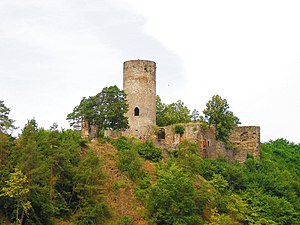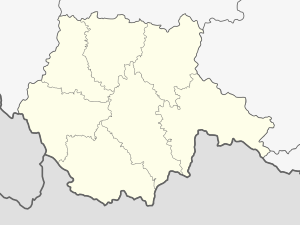Dobronice Castle
| Dobronice | ||
|---|---|---|
|
Dobronice castle ruins |
||
| Alternative name (s): | Dobronitz | |
| Creation time : | around 1320 | |
| Castle type : | Höhenburg, spur location | |
| Conservation status: | ruin | |
| Place: | Dobronice u Bechyně | |
| Geographical location | 49 ° 20 ′ 21 ″ N , 14 ° 30 ′ 2 ″ E | |
| Height: | 385 m nm | |
|
|
||
The ruins of the Dobronice Castle (German Dobronitz Castle ) are located in Dobronice u Bechyně in Okres Tábor in the Czech Republic .
geography
The ruin of the spur castle is located at the southeast exit of the village Dobronice u Bechyně in the Bechin hill country ( Bechyňská pahorkatina ) on a spur above the confluence of the Dobronický creek in the Lainitz .
history
The stone castle was built at the beginning of the 14th century and has been the seat of the Vladiken von Dobronitz since 1322 . These held the property until the beginning of the 15th century. After that, different noble families, including the Kraselovský from Kraselov, Sedlecký from Dub and Malovec from Malovice, alternated as owners. Between 1455 and 1459 the castle belonged to the Rosenbergs . They sold Dobronitz to their burgrave on Choustník , Veit von Zrzawa ( Vít ze Rzavého ). From 1527 the Haslauer von Haslau acquired the rule from the Haas von Zrzawa and Stahletz. After Heinrich Haslauer's death, the rule was divided between his five sons. Christoph Haslauer received half of the castle and half of the villages Rataje, Staré Sedlo, Zběšice and Dobronice. In 1594, when Christoph Haslauer had acquired three quarters of the castle and the lordship, he bought the Ratay estate and had a new seat built there. According to Christoph Haslauer's last will, written in 1616, his property was to be divided among his six sons. When Christoph Haslauer died in 1618, the Thirty Years' War had broken out. The confiscation commission set up after the Battle of White Mountain in 1620 condemned the brothers Heinrich d. J. and Johann d. J. Haslauer on the loss of a third of their property. Part of the lordship was confiscated in 1620, another part fell to the court chamber in 1636 because Bohuslav Nestor Haslauer, who had died in the meantime, failed to pay claims. This had already sold the Rataje estate in 1621 for 6000 shock to Adam Reichsgraf von Sternberg , Ferdinand Prüger von Greinburg received the rest of the rule. His daughter Anna Jakobine sold Dobronitz in 1691 to the rector of the Prague Clementinums , Wenzel Sattenwolf. The Jesuit order used the castle as a summer residence. In 1727 the castle was attached to the Opařany lordship and after the Jesuit ban in 1773 it was abandoned. In 1790, the lordly administrator Franz Halbiger had walls and roofs torn down for the extraction of building materials. In 1825, Karl von Paar's widow Quidobaldina bought the ruin at an auction and gave it to her rule Bechin .
The first work to prevent the ruins from sliding into the Lainsitztal was carried out in 1890. However, excavations caused by road construction work in the Lainsitztal in 1915 caused parts of the ruins to slide. From 1920 the Czech Tourist Club took over the security work. After the expropriation of the Princely Couple in 1948, no maintenance work was initially carried out. In 1973 amateur securing work was carried out on the tower using concrete.
Since the restitution, the ruin has been owned by Panství Bechyně sro and is accessible on weekends for an entrance fee.
investment
The dominant cylindrical keep and the remains of the Gothic palace from the 14th century and residential buildings and a chapel from the 16th century have been preserved up to the first floor . The remains of the moat are also visible.

